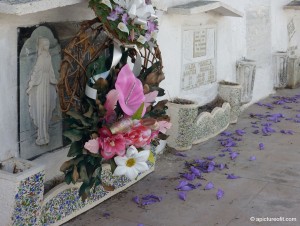[header: Chichicastenango, Guatemala]
One of my favorite sights to try to locate in any new place is the local cemetery.
They are so often a sort of barometer of the locale, like another kind of ‘house-pride’ that suggests the warmth and family values of the local population.My current exposure to Latin American cemeteries is limited, so far, to only three countries: Cuba, Guatemala and Mexico. The cementarios in these three countries are stylistically entirely distinct. The cemeteries in Cuba are quiet and orderly. Those in Yucatecan Mexico, Campeche and eastern Chiapas are more colorful, immensely crowded and barely maintained. And those in Guatemala vary from the relatively dignified, spacious rows in Antigua to the cemeteries of the Mayan villages which are often wildly colorful and varied, but always lovingly cared for.
In Cuba the cemeteries (at least the several that I visited) are almost entirely white with touches of black and only the most minimal presence of other colors. The layouts are orderly and spacious and even the older sections seem relatively well maintained. Departures from this prevailing standard seem to occur mostly as a result of the large number of families who have left the country since the Revolution.
Denoting the high regard and importance of cemeteries in Cuba, several have been given National Monument status. Havana’s one hundred forty acre Cementerio de Cristóbal Colón, notable historically, architecturally and artistically, was established in 1876, replacing el Cementerio Espada which was eventually unable to properly accommodate the huge number of victims of the Cholera epidemic of 1868. With time, Cementario Colon has also filled completely. After three years in the ground, remains are now disinterred and boxed, and are stored in apartment complexes for the dead.
In Cienfuegos there are two cemeteries with National Monument status: Cementario la Reina and Necrópolis Tomás Acea.
And in Santiago de Cuba, Cementerio Santa Ifigenia, established in 1868 to accommodate victims of the War of Independence and of an outbreak of yellow-fever, contains the mausoleum for José Martí. Guards are changed every 30 minutes during which time all visitors must pause and stand at attention.
The cemeteries I visited in Mexico could not be more different. Where the Cuban cemeteries had wide boulevards making all parts of the site easily accessible, in the Mexican cemeteries barely a way through can be found. The newer portions will have a few walkable routes, but the older portions are entirely cut off. To get back to these older areas one must squeeze between monuments and often use the older slabs as walkways. Weeds abound. Evidence of maintenance is sparse. Given the importance of Dia de Muertos in Mexico, I found this quite puzzling.
Guatemala presented an interesting melding of the two extremes presented in Cuba and in Southern Mexico. In Antigua, and in other colonial cities, the cemeteries were orderly and spacious. quiet and rather classic, with many similarities to the aesthetic found in Cuba. The indigenous villages were a another matter entirely. Each area had subtle differences, but most often color was used with abandon and joy.
In this post on the cemeteries of Antigua and the surrounding region, one can see this classical form gradually transitioning to the far more colorful Maya adaptations.
More Cemeteries in Guatemala:
San Marcos La Laguna, rural Peten, Uspantán
Quiché and Chichicastenango
More from the Ixil Triangle: Chajul and Acul
To those like myself who find cemeteries to be fascinating and peaceful places, I dedicate this collection of images.

